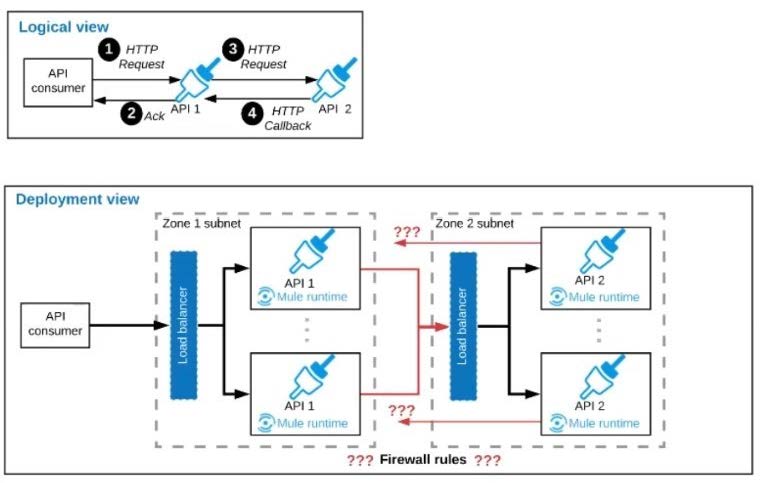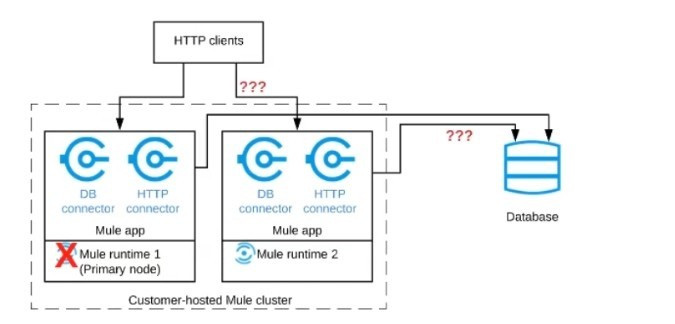Exam Details
Exam Code
:MCIA-LEVEL-1-MAINTENANCEExam Name
:MuleSoft Certified Integration Architect - Level 1 MAINTENANCECertification
:MuleSoft Certified ArchitectVendor
:MulesoftTotal Questions
:116 Q&AsLast Updated
:Jun 01, 2025
Mulesoft MuleSoft Certified Architect MCIA-LEVEL-1-MAINTENANCE Questions & Answers
-
Question 161:
In one of the critical payment related mule application, transaction is being used . As an enhancement to implementation , scatter gather route is introduced which is also the part of transaction group. Scatter gather route has 4 routes.
What will be the behavior of the Mule application in case of error occurs in 4th route of the scatter-gather router and transaction needs to be rolled back?
A. Only errored route will be rolled back
B. All routes will be rolled back
C. Scatter Gather router cannot be part of transaction
-
Question 162:
An organization is designing the following two Mule applications that must share data via a common persistent object store instance:
- Mule application P will be deployed within their on-premises datacenter.
-Mule application C will run on CloudHub in an Anypoint VPC.
The object store implementation used by CloudHub is the Anypoint Object Store v2 (OSv2).
what type of object store(s) should be used, and what design gives both Mule applications access to the same object store instance?
A. Application P uses the Object Store connector to access a persistent object store Application C accesses this persistent object store via the Object Store REST API through an IPsec tunnel
B. Application C and P both use the Object Store connector to access the Anypoint Object Store v2
C. Application C uses the Object Store connector to access a persistent object Application P accesses the persistent object store via the Object Store REST API
D. Application C and P both use the Object Store connector to access a persistent object store
-
Question 163:
49 of A popular retailer is designing a public API for its numerous business partners. Each business partner will invoke the API at the URL 58. https://api.acme.com/partnefs/vl. The API implementation is estimated to require deployment to 5 CloudHub workers.
The retailer has obtained a public X.509 certificate for the name apl.acme.com, signed by a reputable CA, to be used as the server certificate.
Where and how should the X.509 certificate and Mule applications be used to configure load balancing among the 5 CloudHub workers, and what DNS entries should be configured in order for the retailer to support its numerous business partners?
A. Add the X.509 certificate to the Mule application's deployable archive, then configure a CloudHub Dedicated Load Balancer (DLB) for each of the Mule application's CloudHub workers Create a CNAME for api.acme.com pointing to the DLB's A record
B. Add the X.509 certificate to the CloudHub Shared Load Balancer (SLB), not to the Mule application Create a CNAME for api.acme.com pointing to the SLB's A record
C. Add the X.509 certificate to a CloudHub Dedicated Load Balancer (DLB), not to the Mule application Create a CNAME for api.acme.com pointing to the DLB's A record
D. Add the x.509 certificate to the Mule application's deployable archive, then configure the CloudHub Shared Load Balancer (SLB) for each of the Mule application's CloudHub workers Create a CNAME for api.acme.com pointing to the SLB's A record
-
Question 164:
Refer to the exhibit.

A business process involves two APIs that interact with each other asynchronously over HTTP. Each API is implemented as a Mule application. API 1 receives the initial HTTP request and invokes API 2 (in a fire and forget fashion) while API
2, upon completion of the processing, calls back into API l to notify about completion of the asynchronous process.
Each API Is deployed to multiple redundant Mule runtimes and a separate load balancer, and is deployed to a separate network zone.
In the network architecture, how must the firewall rules be configured to enable the above Interaction between API 1 and API 2?
A. To authorize the certificate to be used both APIs
B. To enable communication from each API's Mule Runtimes and Network zone to the load balancer of the other API
C. To open direct two-way communication between the Mule Runtimes of both API's
D. To allow communication between load balancers used by each API
-
Question 165:
Anypoint Exchange is required to maintain the source code of some of the assets committed to it, such as Connectors, Templates, and API specifications.
What is the best way to use an organization's source-code management (SCM) system in this context?
A. Organizations should continue to use an SCM system of their choice, in addition to keeping source code for these asset types in Anypoint Exchange, thereby enabling parallel development, branching, and merging
B. Organizations need to use Anypoint Exchange as the main SCM system to centralize versioning and avoid code duplication
C. Organizations can continue to use an SCM system of their choice for branching and merging, as long as they follow the branching and merging strategy enforced by Anypoint Exchange
D. Organizations need to point Anypoint Exchange to their SCM system so Anypoint Exchange can pull source code when requested by developers and provide it to Anypoint Studio
-
Question 166:
Refer to the exhibit.

A Mule application is deployed to a cluster of two customer-hosted Mute runtimes. The Mute application has a flow that polls a database and another flow with an HTTP Listener.
HTTP clients send HTTP requests directly to individual cluster nodes.
What happens to database polling and HTTP request handling in the time after the primary (master) node of the cluster has railed, but before that node is restarted?
A. Database polling continues Only HTTP requests sent to the remaining node continue to be accepted
B. Database polling stops All HTTP requests continue to be accepted
C. Database polling continues All HTTP requests continue to be accepted, but requests to the failed node Incur increased latency
D. Database polling stops All HTTP requests are rejected
-
Question 167:
A project team uses RAML specifications to document API functional requirements and deliver API definitions. As per the current legal requirement, all designed API definitions to be augmented with an additional non-functional requirement to protect the services from a high rate of requests according to define service level agreements.
Assuming that the project is following Mulesoft API governance and policies, how should the project team convey the necessary non-functional requirement to stakeholders?
A. Create proxies in API manager for the non functional requirement and publish to exchange
B. Add all non functional requirements as comments to RAML specification and publish to exchange
C. Create various SLA's in API manager for the non functional requirement and publish to exchange
D. Update API definitions with the fragment for the appropriate policy and publish to exchange
-
Question 168:
In which order are the API Client, API Implementation, and API interface components called in a typical REST request?
A. API Client > API implementation > API Interface
B. API interface > API Client > API Implementation
C. API Client > API Interface > API implementation
D. API Implementation > API Interface > API Client
-
Question 169:
A developer is examining the responses from a RESTful web service that is compliant with the Mypertext Transfer Protocol (HTTP/1.1) a8 defined by the Internet Engineering Task Force (IETF).
In this HTTP/1.1-compliant web service, which class of HTTP response status codes should be specified to indicate when client requests are successfully received, understood, and accepted by the web service?
A. 3xx
B. 2xx
C. 4xx
D. 5xx
-
Question 170:
A company is designing an integration Mule application to process orders by submitting them to a back-end system for offline processing. Each order will be received by the Mule application through an HTTP5 POST and must be acknowledged immediately.
Once acknowledged the order will be submitted to a back-end system. Orders that cannot be successfully submitted due to the rejections from the back-end system will need to be processed manually (outside the banking system).
The mule application will be deployed to a customer hosted runtime and will be able to use an existing ActiveMQ broker if needed. The ActiveMQ broker is located inside the organization's firewall. The back-end system has a track record of unreliability due to both minor network connectivity issues and longer outages.
Which combination of Mule application components and ActiveMQ queues are required to ensure automatic submission of orders to the back-end system while supporting but minimizing manual order processing?
A. One or more On Error scopes to assist calling the back-end system An Untill successful scope containing VM components for long retries A persistent dead-letter VM queue configure in Cloud hub
B. An Until Successful scope to call the back-end system One or more ActiveMQ long-retry queues One or more ActiveMQ dead-letter queues for manual processing
C. One or more on-Error scopes to assist calling the back-end system one or more ActiveMQ long-retry queues A persistent dead-letter Object store configuration in the CloudHub object store service
D. A batch job scope to call the back in system An Untill successful scope containing Object Store components for long retries. A dead-letter object store configured in the Mule application
Related Exams:
Tips on How to Prepare for the Exams
Nowadays, the certification exams become more and more important and required by more and more enterprises when applying for a job. But how to prepare for the exam effectively? How to prepare for the exam in a short time with less efforts? How to get a ideal result and how to find the most reliable resources? Here on Vcedump.com, you will find all the answers. Vcedump.com provide not only Mulesoft exam questions, answers and explanations but also complete assistance on your exam preparation and certification application. If you are confused on your MCIA-LEVEL-1-MAINTENANCE exam preparations and Mulesoft certification application, do not hesitate to visit our Vcedump.com to find your solutions here.
